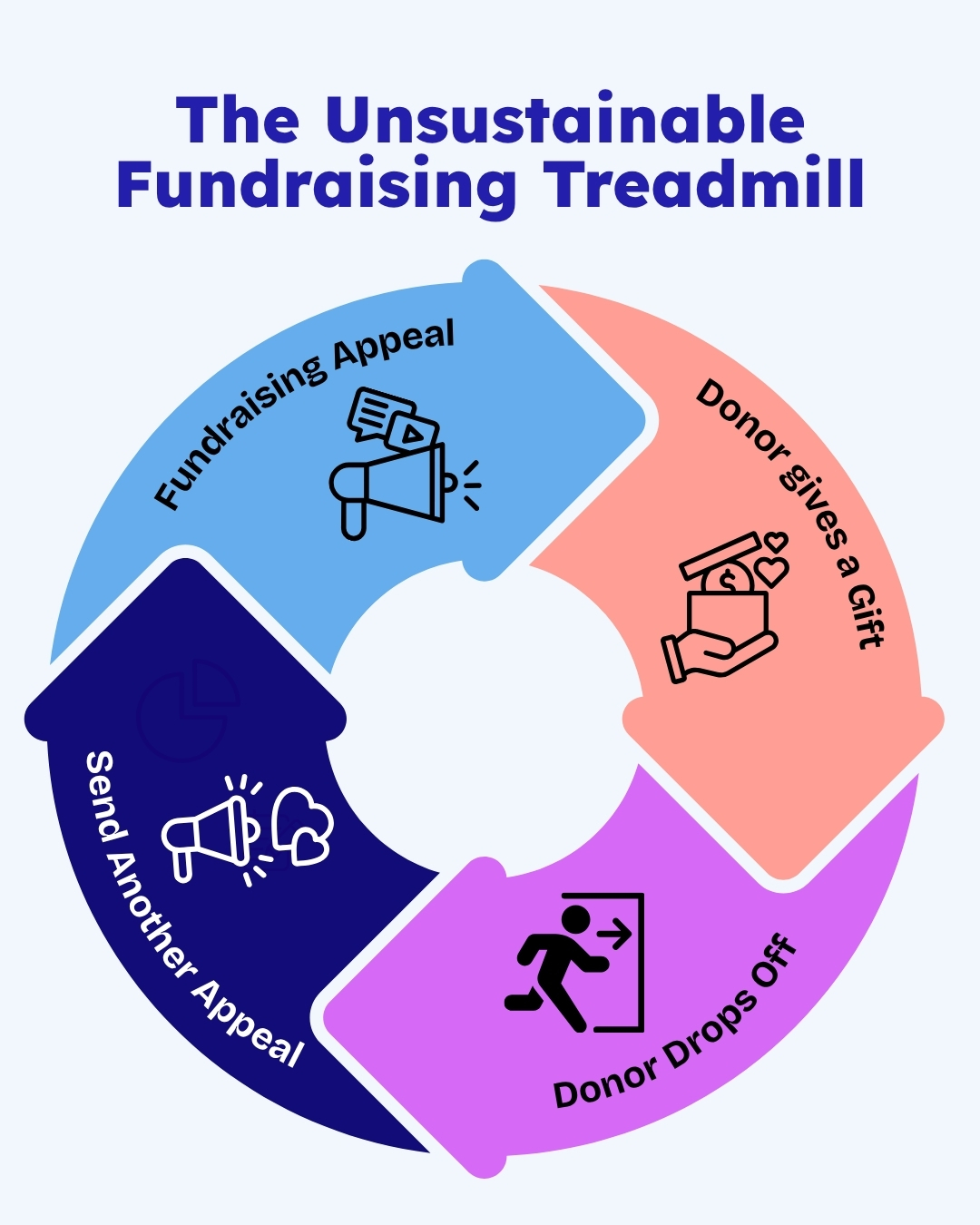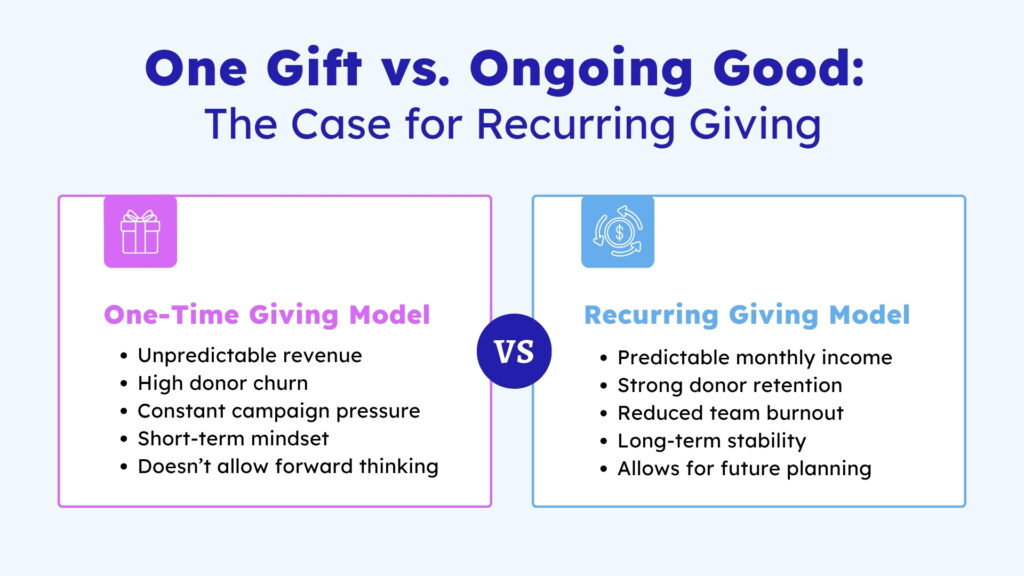Why Recurring Giving Is the Antidote to Fundraising Fatigue

It’s nearly the quarter-end and your team is once again scrambling to meet revenue goals. Sound familiar?
Your team is likely caught in a cycle of constant asks, unpredictable revenue, and pressure to perform – also known as fundraising fatigue. And to be honest, it’s likely your donors are feeling it, too.
But there is a way, a strategic way, to combat fundraising fatigue through recurring giving. It isn’t just a revenue stream, but a mindset shift. Recurring giving, often referred to as sustainer or monthly giving, has become one of the most reliable ways to weather economic uncertainty and deepen donor loyalty.
Reduce the pressure on your team and build a healthier fundraising model.
The Hidden Toll of Traditional Fundraising
Too many nonprofits find themselves stuck in a traditional, calendar-based cycle of fundraising events, emergency appeals, and reactive planning in the face of challenging economic forces and funding cuts.
It can be exhausting to meet annual budget goals year after year while navigating increased competition for donor dollars, especially when there’s no time for long-term planning or strategic assessment.
The constant drive for new donor acquisition, meeting revenue goals, and the high cost – in terms of staff time and effort – for planning and executing events with questionable ROI takes its toll.
The reality? Only 46 percent of donors are retained year over year – and that churn has a cost.
Development team members are suffering from burnout, and organizations are operating with unstable cash flow. They are often relying on traditional strategies that focus more on immediate revenue, rather than long-term relationship-building and reliable income streams.

Why Sustainer Giving Changes Everything
Amid this volatility, sustainer giving provides something every nonprofit desperately needs stabilization in uncertain times.
Monthly donations create a predictable revenue stream that allows organizations to plan, invest confidently, and avoid the feast-or-famine cycle that can derail critical work. Unlike major gifts or occasional appeals, recurring donations don’t rely on year-end urgency or one-off emergencies.
Rather, they accumulate quietly, consistently, and powerfully over time:
- The average monthly gift is $52, translating to $624 annually, significantly higher than the average one-time gift.
- The recurring donor retention rate is between 80 and 95%, compared to a sector-wide average of 46% for general donor retention.
- Most monthly donors stay engaged for 5 to 7 years.
- Monthly donors are more likely to upgrade, contribute special gifts, and convert to mid-level or planned giving over time.
In fact, monthly donors now contribute more than 30% of digital fundraising revenue.
Sustainer giving provides for predictable income, which allows nonprofit teams to:
- Forecast more accurately
- Reduce reliance on crisis campaigns
- Focus energy on cultivation, strategy, and storytelling

The Human Impact: Less Hustle, More Strategy
One mid-size arts nonprofit relied on the usual calendar approach to fundraising. It sent appeals every six to eight weeks in addition to putting on a series of fundraising events throughout the year. Staff were overworked, and donors weren’t given the attention – or giving options – they deserved.
By embracing recurring giving and focusing on the long term, staff members got off the hamster wheel. They stopped chasing big gifts and endless events, reported less stress, and were finally able to:
- Deepen donor relationships – helping donors feel seen, heard, and valued
- Explore planned giving and mid-level strategies
- Focus on innovation and storytelling instead of fire drills
Donor loyalty has deepened and has translated into advocacy and volunteerism. They aren’t just donors — they’re community members.
Building Buy-In Internally
Despite the benefits, many sustainer programs remain under resourced. They’re often neglected, misunderstood, or misused. Changing that mindset starts with building an internal business case.
Nonprofit leaders need to shift the perception of monthly giving from a passive donor preference to an active strategic priority.
Here’s how to make the case:
- Show the math for the cost per donor vs. lifetime value. It may cost a bit more upfront ($25 to $100+ per donor) but the donor lifetime value is significantly higher and more stable than one-time donors ($300-$1,000+)
- Highlight staff time savings and mental energy. Burnout is reduced when staff stops operating in emergency mode and can focus on planning and developing donor relationships.
- Tie it to mission stability. Predictably, stable income means organizations can move the needle on big-picture goals and programmatic success.
- Talk about long-term ROI over short-term wins. Recurring giving reduces cash flow worries and enables more reliable budgets.
Need help quantifying the impact of recurring giving for your team?
The First Step: Start Simple, Grow Smart
The good news? You don’t need a big flashy rollout to start a successful recurring giving program. Start with a small, focused campaign targeting your most loyal supporters and build from there.
Give your program a name that reflects your mission and invites donors to see themselves as partners in lasting change (ex. Community Changemakers)
Most importantly, prioritize a warm onboarding experience and consistent stewardship. A heartfelt welcome email, impact updates, and small thank-you moments go a long way in keeping monthly donors engaged.
Rember, this shift to recurring giving isn’t just about revenue — it’s about sustainability. A strong sustainer program brings predictable funding for your mission and relieves staff from the exhausting cycle of constant fundraising.
Start simple and grow your program strategically. The long-term payoff is worth it.
Conclusion
Building a recurring giving program isn’t just a smart fundraising strategy, it’s a powerful step toward stability, sustainability, and stronger donor relationships. By creating a reliable revenue stream, you free your team from the constant pressure of chasing one-time gifts and offer donors a more meaningful way to stay engaged.
Far from competing with other forms of support, recurring giving cultivates deeper loyalty and long-term generosity. It’s not just a fundraising tool. It’s a loyalty-building model that pays dividends well beyond the monthly gift.
In a world where uncertainty is the norm, sustainer giving is your best stability strategy. Ready to create lasting impact? Launch your sustainer program today and build a future you can count on.
Our team at Allegiance Group + Pursuant are ready to help you build a recurring giving program and create meaningful relationships that inspire lifelong giving among your supporters. Connect with us today